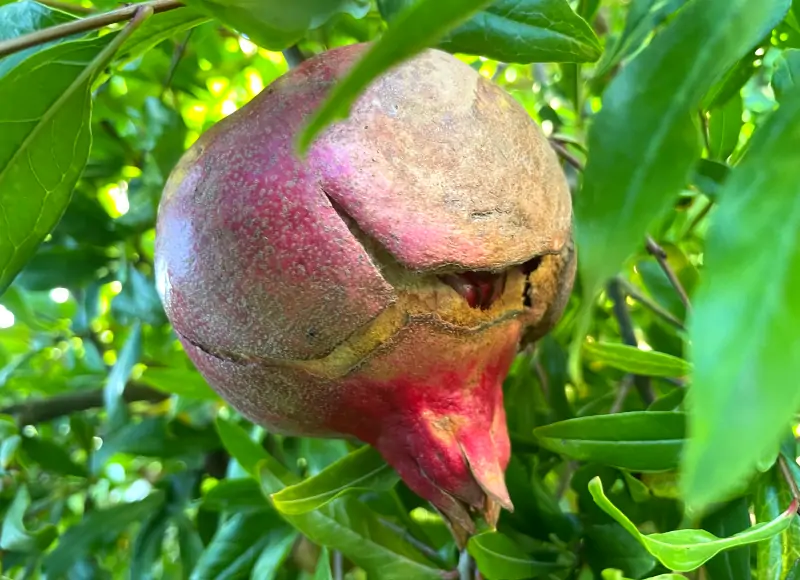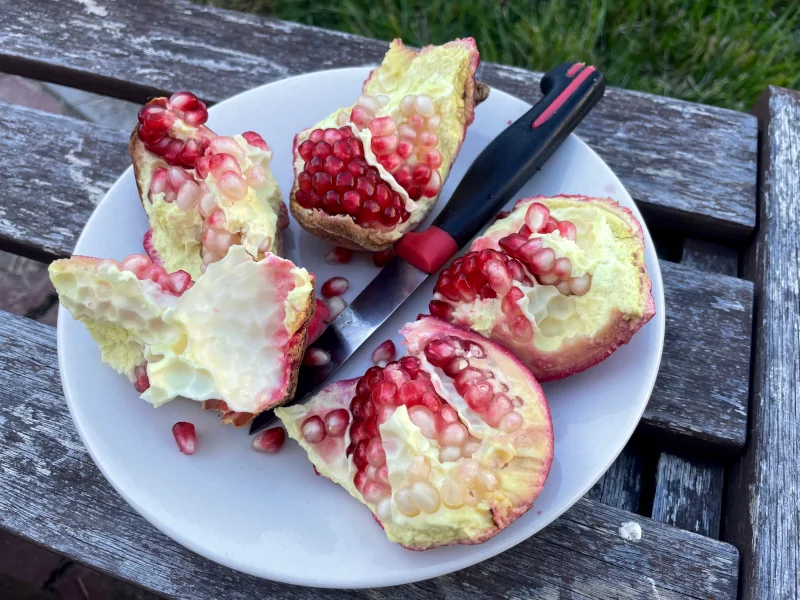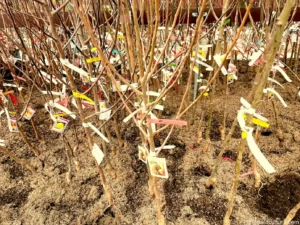Pomegranate season is something many growers look forward to. The fruit is highly prized for its delicious taste and attractive appearance.
Typically a fall fruit, pomegranates require a long period to develop, ripening about 6 to 7 months after their spring bloom.
Given all this anticipation, it is of course disheartening to come upon cracked pomegranates in your orchard.
As you see the skin split open and the precious seeds inside ready to burst out, you might wonder if you did anything wrong to bring about such an untimely disaster.
However, it is important to emphasize that it is not at all unusual for pomegranates to split. Yes, there are things you can do to minimize the risk of it happening but in the grand scheme of things, your culpability is limited.
This kind of setback can occur even on a commercial scale. It’s just that it typically goes unnoticed as far as consumers are concerned. For obvious reasons of marketability, only pristine pomegranates make it to grocery stores. Otherwise blemished fruit is hard to sell. Incidentally, this is not just true for pomegranates but many other types of fruit as well.
If you grow pomegranates for yourself, on the other hand, then your priorities are going to be somewhat different.
You will want to know what caused your pomegranates to split, if there was anything you could have done to prevent it and ultimately if they are still edible. All that is what we will be going over in more detail next.
Reason 1: Inconsistent Watering
If your pomegranates split in summer or early fall, before the time they are usually expected to ripen, then inconsistent watering is probably the main culprit.
It’s easy to understand why when you visualize the pomegranate as two parts.
The first part is the exterior, that is the skin of the pomegranate. The second part is the interior, mainly consisting of the juicy pomegranate seeds.
With regular water, about the same volume each week, these two parts grow more or less in tandem, just at the right pace. However, when you have a dry spell followed by much more water later on, this simultaneous growth cycle becomes imbalanced.
The interior then takes on the extra water and ends up growing more quickly than the exterior can keep up with. As a result, the pomegranate skin gets stretched and eventually splits open.
Incidentally, the larger pomegranates, which are further along in their growth phase and have more interior mass, are more susceptible to cracking in this situation.
In effect, you can minimize the risk of pomegranates splitting by keeping up a regular irrigation schedule for your pomegranate shrubs, about the same volume of water each week. This will promote growth at a measured pace.
That said, it can still be a challenge to prevent it from happening altogether.
Splitting can take place naturally even without your involvement. You could be doing everything right and watering your pomegranate trees on a regular schedule but then Mother Nature suddenly comes around and throws a wrench into your efforts by delivering a major rain storm.
This is why it is important for you to keep a close eye on your orchard.
Reason 2: Overripening
Another very common reason for cracked pomegranates is overripening. As you might expect, this tends to happen more often in mid or late fall. And traditionally, this type of splitting is considered more benign.
It does not mean that there is a problem with the tree. On the contrary, it’s normal for pomegranates to split open eventually. After all, it is a way for the plant to spread its seed and propagate. Even if you continued to water consistently, it would come about at some point.
In other words, you are not really do anything wrong to cause this, other than perhaps waiting a bit too long. And even then, there is still an upside to it.
Normally, you won’t see all of the pomegranates on the tree splitting open at the same time. A small number of pomegranates, perhaps less than a handful, will overripen and crack first and this can then be used to your advantage.
Indeed, there are growers who will wait for precisely this moment to happen as a signal to start harvesting the remaining fruit from the tree, the idea being that the pomegranates are pretty much at peak ripeness at that point.
Reason 3: Pests and Diseases
Fortunately, pomegranates are quite resilient and much less vulnerable to pests and diseases than many other types of fruit trees.
As one can imagine, the thick rind of the pomegranate makes it rather difficult for animals and insects to get to the arils in the interior. Some rodents such as squirrels are quite capable of gnawing their way through, though they ultimately prefer to munch on nuts and other fruits when given a choice.
Indeed, pests are much more likely to become a problem after the fact, for example after the pomegranate already started to split.
Diseases can be a concern, especially when pomegranates are grown outside of ideal conditions. In humid climates in particular, pomegranates are susceptible to fungal diseases. These do not just blemish the outer appearance of the fruit. They also weaken the skin and make it easier again for pests to make their way in, effectively cracking the pomegranate open.
Nevertheless, it’s worth reiterating that this is the least likely of all causes. The vast majority of the time when you see a cracked pomegranate, it is due to one of the previously mentioned reasons, inconsistent watering or overripening rather than pests or diseases.
Are Cracked Pomegranates Okay to Eat?
In the event that one or more of your pomegranates split open, how can you tell whether the fruit is still good to eat?
The answer to that is firm and unequivocal: it depends.
To be more direct, it depends on the reason why the pomegranate split and its current condition.
Evidently, if there are any signs that critters got to it or if anything looks seriously discolored, rotten or diseased, you will be better off passing up the opportunity.
However, if the pomegranate split as a result of irregular watering or overripening, and you get to the fruit early enough, while it still remains untouched by pests, then it should still be edible.
It’s easy to illustrate this scenario by means of an actual example.
The Angel Red pomegranate shown below started to split open after torrential rains in mid-August. Given the circumstances, the crack was most likely caused by irregular watering.

Fortunately, because the problem was noticed early on, within a couple of days of the storm passing, the fruit could still be saved.
In fact, with Angel Red being an early season variety, the fruit had started to ripen already.
In the image below, you can see what the same pomegranate looked like when it was cut open. Many of the pomegranate seeds were bright red, an indicator of ripeness for this variety.

There are of course numerous ways to enjoy a pomegranate. This particular fruit became a delicious addition to a bowl of vanilla ice cream.




![Read more about the article Anna Apple – Profile and Review [Photos]](https://orchardculture.com/wp-content/uploads/2023/08/anna-apple-branch-300x234.webp)
![Read more about the article Babcock Peach – Profile and Review [Photos]](https://orchardculture.com/wp-content/uploads/2023/08/peach-tree-branch-2-300x200.webp)